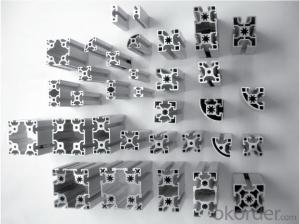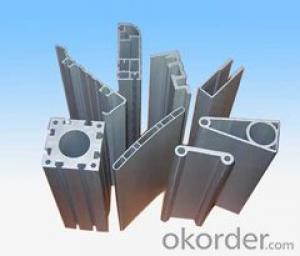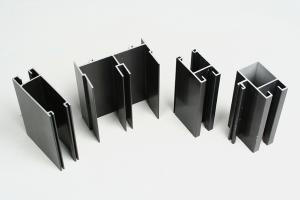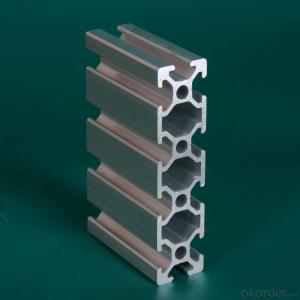Wholesale Aluminum Extrusion Profiles for Carbody Aluminium Sidewall Profile
- Loading Port:
- China Main Port
- Payment Terms:
- TT OR LC
- Min Order Qty:
- -
- Supply Capability:
- -
OKorder Service Pledge
Quality Product, Order Online Tracking, Timely Delivery
OKorder Financial Service
Credit Rating, Credit Services, Credit Purchasing
You Might Also Like
Carbody Aluminium Sidewall车体侧墙型
1. Usage:High-speed railway and Metro
2. Surface: Mill finish or anodized etc. based on customer’s needs
3. Alloy: alloy temper 6005A
4. Size: various size available based on customer’s requirement
5. Package: Standard packaging
6. Standard: EN755
7. Lead time: shortest delivery time
- Q: This question asks about the various types of aluminum profiles that are utilized in the construction of insulation systems.
- <p>Aluminum profiles used for building insulation come in various types, each serving specific functions. These include: 1. Insulation profiles, which provide a thermal barrier; 2. Structural profiles, used for structural support; 3. Cover profiles, which protect the insulation material; 4. Joint profiles, used for sealing joints; 5. Corner profiles, for reinforcing corners; 6. Edge profiles, for finishing edges; and 7. Special profiles, designed for specific applications. Each type is engineered to enhance thermal efficiency and structural integrity in building insulation systems.</p>
- Q: This question asks if aluminum profiles can be utilized in cold weather conditions and seeks an explanation for their suitability.
- <p>Yes, aluminum profiles can be used in cold climates. Aluminum is a lightweight and durable material that maintains its strength and structural integrity even in extreme low temperatures. It does not rust or corrode, which makes it ideal for use in environments with harsh weather conditions. Additionally, aluminum has good thermal conductivity, which allows it to dissipate heat effectively, but it also has low thermal expansion, meaning it does not expand or contract significantly with temperature changes. This characteristic helps prevent warping or cracking in cold climates. Properly designed and installed aluminum profiles can withstand the challenges of cold weather without compromising their performance or longevity.</p>
- Q: Is it possible to utilize aluminum profiles in interior design projects?
- <p>Yes, aluminum profiles can be used for interior design. They are popular for their strength, durability, and modern aesthetic. Aluminum profiles are lightweight, easy to install, and resistant to corrosion, making them suitable for various applications such as window frames, door frames, shelving systems, and decorative elements. They can be powder-coated or anodized to achieve different colors and finishes, allowing for a wide range of design flexibility.</p>
- Q: What are the applications of aluminum profiles?
- Aluminum profiles have a wide range of applications across various industries. They are commonly used in construction for window frames, door frames, curtain walls, and roofing systems due to their lightweight, durability, and corrosion resistance. In the automotive industry, aluminum profiles are utilized in the manufacturing of vehicle frames, body panels, and heat exchangers, contributing to improved fuel efficiency. Additionally, these profiles find application in the production of furniture, industrial machinery, electrical enclosures, and transportation systems.
- Q: What are the methods to prevent water infiltration in the gaps between aluminum profiles during the installation process?
- <p>To prevent water from getting into gaps between aluminum profiles during installation, use high-quality sealants and gaskets. Ensure proper alignment and fit of the profiles to minimize gaps. Install weep holes to allow water to drain out. Apply a water-resistant membrane or flashing behind the profiles. Regularly inspect and maintain the installation to identify and fix any issues promptly. Proper installation techniques and materials selection are crucial to prevent water infiltration.</p>
- Q: Are aluminum profiles suitable for furniture applications?
- Yes, aluminum profiles are suitable for furniture applications. Aluminum is a versatile and lightweight material that offers several advantages for furniture design and construction. Firstly, aluminum profiles provide excellent strength and durability, making them ideal for furniture that needs to withstand regular use and weight-bearing. They are resistant to corrosion, which means they can be used both indoors and outdoors without the risk of rusting or deteriorating over time. Additionally, aluminum profiles offer flexibility in design. They can be easily shaped and formed into various shapes and sizes, allowing for creative and innovative furniture designs. Aluminum profiles can also be extruded into different profiles and sections, enabling customization and adaptability to different furniture styles and requirements. Furthermore, aluminum is a sustainable material that can be recycled repeatedly without losing its properties. This makes it an environmentally friendly choice for furniture applications. Overall, aluminum profiles provide a combination of strength, durability, versatility, and sustainability, making them a suitable choice for various furniture applications.
- Q: This question asks for a description of the various dimensions and forms of aluminum profiles that are utilized in siding systems.
- <p>Aluminum profiles for siding systems come in a variety of sizes and shapes to accommodate different architectural styles and structural requirements. Common profiles include flat bars, channels, angles, and Z-profiles. Sizes can range from narrow trims of 10mm to wide panels of over 200mm in width, with thicknesses typically from 0.5mm to 3mm. Shapes are designed for specific functions, such as interlocking for a seamless appearance, or with grooves for attaching insulation. Custom profiles are also available for unique applications. These profiles are chosen based on the building's design, load-bearing needs, and aesthetic preferences.</p>
- Q: Explain the various uses of aluminum profiles in architectural design.
- <p>Aluminum profiles have a wide range of applications in architectural design due to their strength, durability, and versatility. They are commonly used for curtain walls, which provide a sleek and modern appearance while offering thermal insulation. Aluminum profiles are also used in window and door frames for their lightweight and strong properties, enhancing security and energy efficiency. They are integral in the construction of sun shading systems and louvers, which help control light and heat in buildings. Additionally, aluminum profiles are used in structural components like beams and columns, as well as in decorative elements such as facades and balustrades, offering both functional and aesthetic benefits.</p>
- Q: Inquire if aluminum profiles can be recycled locally or regionally and how to find more information about it.
- <p>Yes, aluminum profiles can be recycled both locally and regionally. Recycling aluminum is an efficient process that conserves resources and energy. To find out more about local recycling options for aluminum profiles, you can: 1) Contact your local waste management or recycling center to inquire about their services. 2) Search online for recycling facilities in your region that specialize in aluminum. 3) Reach out to local metal scrapyards, as they often accept aluminum for recycling. 4) Check with local environmental agencies or non-profit organizations focused on recycling for guidance and resources.</p>
- Q: Can aluminum profiles be used in solar mounting systems?
- Yes, aluminum profiles can be used in solar mounting systems. Aluminum is a popular material choice for solar mounting systems due to its lightweight, corrosion resistance, and strength properties. It provides a durable and cost-effective solution for securely mounting solar panels onto various surfaces.
Send your message to us
Wholesale Aluminum Extrusion Profiles for Carbody Aluminium Sidewall Profile
- Loading Port:
- China Main Port
- Payment Terms:
- TT OR LC
- Min Order Qty:
- -
- Supply Capability:
- -
OKorder Service Pledge
Quality Product, Order Online Tracking, Timely Delivery
OKorder Financial Service
Credit Rating, Credit Services, Credit Purchasing
Similar products
Hot products
Hot Searches
Related keywords
























